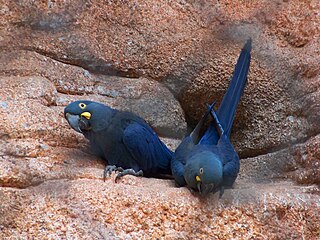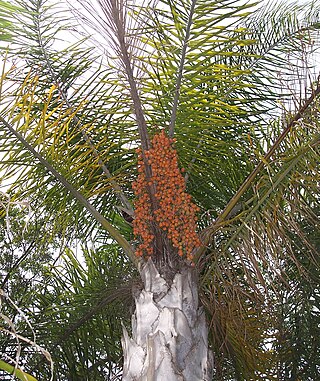
The International Union for Conservation of Nature (IUCN) Red List of Threatened Species, also known as the IUCN Red List or Red Data Book, founded in 1964, is an inventory of the global conservation status and extinction risk of biological species. A series of Regional Red Lists are produced by countries and organizations, which assess the risk of extinction to species within a political management unit.

Lear's macaw, also known as the indigo macaw, is a large all-blue Brazilian parrot, a member of a large group of neotropical parrots known as macaws. It was first described by Charles Lucien Bonaparte in 1856. Lear's macaw is 70–75 cm long and weighs around 950 g. It is coloured almost completely blue, with a yellow patch of skin at the base of the heavy, black bill.

The conservation status of a group of organisms indicates whether the group still exists and how likely the group is to become extinct in the near future. Many factors are taken into account when assessing conservation status: not simply the number of individuals remaining, but the overall increase or decrease in the population over time, breeding success rates, and known threats. Various systems of conservation status are in use at international, multi-country, national and local levels, as well as for consumer use such as sustainable seafood advisory lists and certification. The two international systems are by the International Union for Conservation of Nature (IUCN) and The Convention on International Trade in Endangered Species of Wild Fauna and Flora (CITES).

Syagrus is a genus of Arecaceae (palms), native to South America, with one species endemic to the Lesser Antilles. The genus is closely related to the Cocos, or coconut genus, and many Syagrus species produce edible seeds similar to the coconut.

A least-concern species is a species that has been categorized by the International Union for Conservation of Nature (IUCN) as evaluated as not being a focus of species conservation because the specific species is still plentiful in the wild. They do not qualify as threatened, near threatened, or conservation dependent.

Syagrus romanzoffiana, the queen palm or cocos palm, is a palm native to South America, introduced throughout the world as a popular ornamental garden tree. S. romanzoffiana is a medium-sized palm, quickly reaching maturity at a height of up to 15 m (49 ft) tall, with pinnate leaves having as many as 494 pinnae (leaflets), although more typically around 300, each pinna being around 50 centimetres (18 in) in length and 3–5 centimetres (1–2 in) in width.

Syagrus coronata, commonly known as the ouricury palm, aricuri palm, or licuri palm, is a species of palm tree that is native to eastern Brazil, ranging from the southern part of the state of Pernambuco, into the state of Bahia, south to the Jequitinhonha River in the state of Minas Gerais. The tree can live for 30–150 years, though most only live for 8–10 years on average. It plays an important role in the diets of tropical seasonally dry forest animals.

The dusky-legged guan is a species of bird in the family Cracidae, the chachalacas, guans, and curassows. It is found in Uruguay, northeastern Argentina and southernmost areas of Paraguay and Brazil. In early 2021, the former subspecies P. o. bridgesi, found in southwestern Bolivia and northwestern Argentina, was elevated to species rank as Yungas guan.

Butia eriospatha is a small species of Butia palm endemic to the highlands of southern Brazil. It is very similar to B. odorata, but is easily distinguished from this species by the distinct spathes which are densely covered in rust-coloured, woolly hairs. Indeed, the specific epithet is derived from Greek ἔριον, wool, and Latin spatha, which refers to the spathe. It has been given the name woolly jelly palm (UK) or wooly jelly palm (US) in English. Vernacular names for it where it is native are butiá-da-serra, butiázeiro, butiá-veludo, butiábutiá verdadeiro, butiá-do-campo, yatáy and macumá.

Syagrus glaucescens is a species of flowering plant in the family Arecaceae. It is endemic to Minas Gerais state in southeastern Brazil. Its small population is threatened by collecting and habitat destruction.
Syagrus macrocarpa is a rare species of palm found only as scattered isolated individuals and small groups in the east of the Brazilian states of Espírito Santo, Minas Gerais and Rio de Janeiro. It grows to 4-10m tall, with 8-20 leaves to 2m long. The leaves are bent at the end, with very hairy margins near the trunk, and consist of 180-320 slightly coiled leaflets irregularly arranged in several planes on the rake. The fruit are oval, greenish-yellow, 6–9 cm long. It is grown in cultivation. Seeds are difficult to germinate, with low rates of germination. Common names for it in Minas Gerais are baba-de-boi-grande and maria-rosa.
Syagrus picrophylla is a species of flowering plant in the family Arecaceae. It is found only in Brazil.

Syagrus pseudococos is a species of flowering plant in the family Arecaceae. It is found in tropical rainforest and on rocky outcrops in eastern Brazil along a coastal strip from extreme south of state of Bahia south through Espírito Santo, Rio de Janeiro to São Paulo.
Syagrus ruschiana is a species of flowering plant in the family Arecaceae. It is found only in Brazil.
Syagrus smithii is a species of palm tree found in Brazil, Colombia, Ecuador and Peru.
Syagrus stratincola is a species of flowering plant in the family Arecaceae. It is found in French Guiana, Guyana, and Suriname. It is threatened by habitat loss.
Tectiphiala ferox, or palmiste bouglé, is a species of flowering plant in the family Arecaceae. It is endemic to Mauritius.

Helicia is a genus of 110 species of trees and shrubs, constituting part of the plant family Proteaceae. They grow naturally in rainforests throughout tropical South and Southeast Asia, including India, Sri Lanka, Indochina, Peninsular Malaysia to New Guinea and as far south as New South Wales.

A vulnerable species is a species which has been categorized by the International Union for Conservation of Nature as being threatened with extinction unless the circumstances that are threatening its survival and reproduction improve.

Butia campicola is a very small species of Butia palm with an underground trunk; native to the cerrados of central Paraguay and south-central Brazil.














